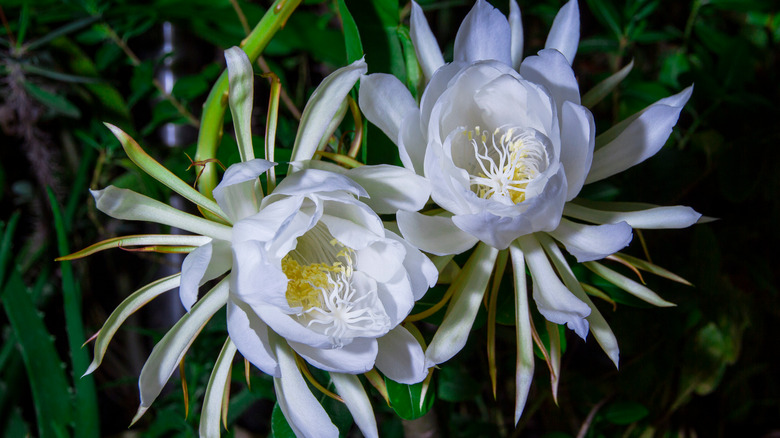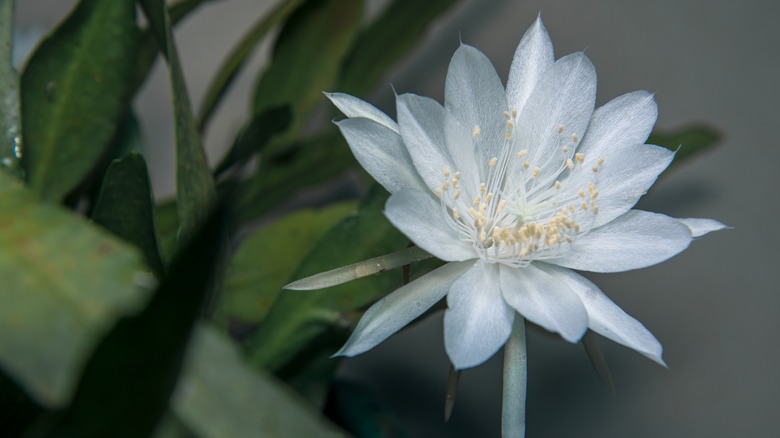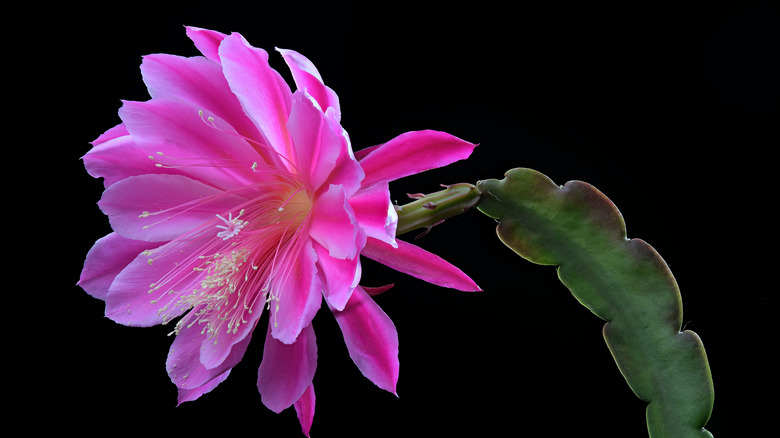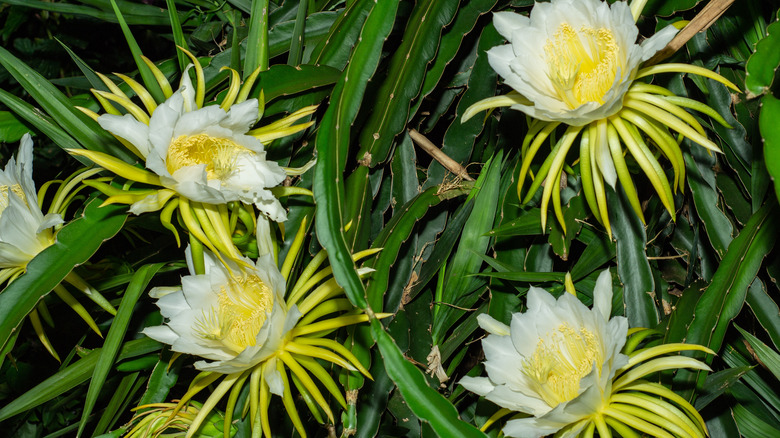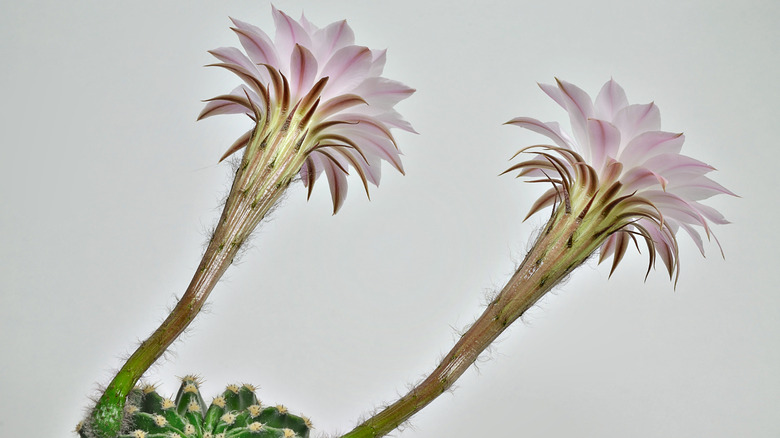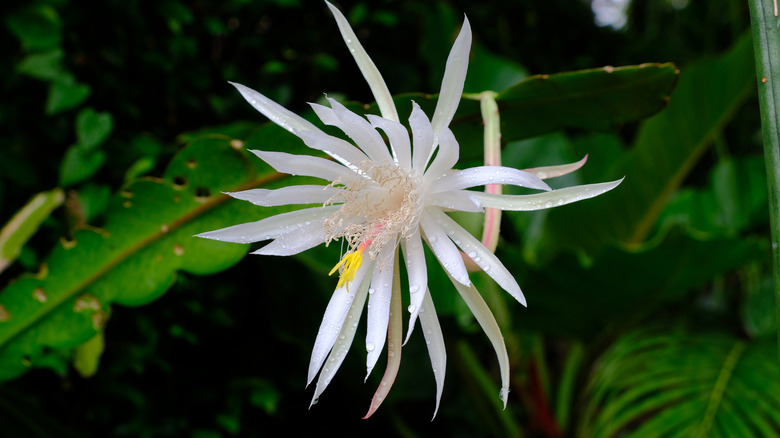How To Care For A Night Blooming Cactus
Night blooming cactus actually refers to a few species of tall-growing cacti whose flowers bloom during the night. The most common types of night blooming cacti you'll find include Epiphyllum oxypetalum, Epiphyllum hookeri, Hylocereus undatus, Peniocereus greggii, Cereus jamacaru, Selenicereus grandiflorus, and Cereus peruvianus, according to The Spruce. That being said, there are many others that fall under the night blooming cactus umbrella.
Night blooming cacti are most often characterized by their leaf-like flat stems and their large blooms that are sometimes described as dinner-plate-sized, per Liquidambar Girl Gardening. Nearly all night blooming cacti are relatively low maintenance, love hot temperatures, and are found in the wild in the warm, tropical regions of Asia, Brazil, and Central America. Night blooming cactus is also known as the Queen of the Night cactus, Orchid cactus, Christ in the Manger, Epiphytic cactus, and Night Blooming Cereus. Keep reading for all you need to know about growing and caring for this plant.
How to use night blooming cactus in garden
Night blooming cacti are rarely introduced into the garden in the U.S. The conditions in most states are much too cold for the cactus to survive for any length of time. However, if you live in USDA hardiness zones 10, 11, or 12, you may have some luck growing Epiphytic cacti as an outdoor perennial. As explained by Gardening Know How, when used outdoors, these plants can grow quite tall, climbing trees to support their weight. In some instances, they'll grow up to 10 feet high if the tree they're growing on is tall enough.
People who live in warmer climates can also choose to grow their night blooming cactus on a trellis or simply keep them in a pot on their patio or in a hanging basket. This works especially well if you live in a colder region as you can bring in the pot or hanging planter during colder nights and seasons.
How to grow night blooming cactus
The best way to grow a night blooming cactus is to buy one that is pre-grown at a nursery or propagate one yourself. Gardeners do not recommend growing these plants from seed as it can be more than a decade before you see any blooms, per House Plants Expert. No matter which growing method you decide to tackle, make sure you buy well-draining soil, such as succulent or cactus potting soil, sterile scissors, and a pot with a drainage hole.
To propagate your own orchid cactus, you'll first need to have access to your favorite species. Maybe you've already grown a night blooming cactus or you have a kind friend who is willing to share. Once you have located a mature, healthy cactus, use your sterile scissors to cut off 4- to 6-inch stems from the plant, as told by Gardenine. Store your cuttings in a cool, dry place for several days as you wait for them to scab over. When the callouses have formed, stick the cut end of the stems into a small pot full of moist potting soil. Plan to water them weekly until they start growing their roots. This can take up to two weeks. When the roots beneath the plant are strong, move the pot to a sunny window and watch for further growth.
How to care for night blooming cactus
Night blooming cacti don't require extensive care as long as you give them everything they need to begin with. The three things these plants need the most are bright, indirect sunlight, moist soil, and fertilizer for blooming, as per Leafy Place. When growing indoors, you should place your Epiphytic cactus in a north- or south-facing window where it won't be bothered by direct sunlight during the mornings and afternoons. If you plan to plant yours outside, be sure that it sits beneath a taller plant or structure so it will be protected during the day.
To water your night blooming cactus, check its soil on a weekly basis. Each time the top inch of soil has dried out, your plant will need watering. Keep in mind that most orchid cacti are native to warm, tropical climates. They must have access to plenty of water and humidity to thrive. However, like most plants, they should not be left sitting in water. Always dump out the drainage tray after watering to prevent root rot and similar diseases.
Fertilizing these cacti is easy. According to Liquidambar Girl Gardening, you should dilute liquid fertilizer with 50% water and apply it during the plant's growing season in the spring, summer, and fall. During the winter, along with your watering schedule, you should reduce and then stop fertilizing your cactus altogether. Allowing it to go dormant will help it bloom in the spring.
Night blooming cactus varieties
The most common night blooming cactus kept as a houseplant is the Epiphyllum oxypetalum, which is known for its fragrant white flowers and flat stems. Different varieties of Epiphytic cacti exhibit similar characteristics, sometimes with brightly colored flowers or slightly different stems. All night blooming cacti are native to tropical regions around the world. The following are some of the most popular types, as explained by The Spruce.
-
Epiphyllum hookeri 'Hooker's Orchid Cactus': This variety resembles Epiphyllum oxypetalum before it produces flowers. However, once it blooms, its skinny white petals give it away.
-
Cereus jamacaru 'Cardeiro': This orchid cactus native to Brazil needs less water than other epiphytic cacti, but more than your average cactus.
-
Cereus peruvianus 'Peruvian Apple Cactus': This pink-and-white blooming cactus can survive in USDA hardiness zones 8 through 11 and sets itself apart from other night blooming cacti with its ability to survive colder temperatures.
-
Selenicereus grandiflorus 'Vanilla Cactus': It has round instead of flat stems and its flowers bloom pink, white, and yellow.
-
Hylocereus undatus 'Dragon Fruit Cactus': This variety blooms for a long time, from July to October. It bears heavy pink fruit called dragon fruit.
-
Peniocereus greggii 'Deer Horn Cactus': It has blooms with skinny petals, unlike most orchid cacti. Its flowers normally appear white, but sometimes they will be pink.
How to repot night blooming cactus
Night blooming cactus only needs to be repotted when there are signs of poor drainage, as per Leafy Place. It is happiest when it is slightly root bound; however, becoming too root bound can make it difficult for water to drain out of the pot. Keep in mind that when you decide to repot your orchid cactus, it may have trouble blooming in the summer due to the stress on its roots. However, it should bounce back the following year.
When you are ready to repot your cactus, plan to water it 24 hours ahead of time to reduce the risk of transplant shock. While repotting, the soil should not be overly wet. In the meantime, gather a pot that is one size up from the last, some well-draining potting soil, and perlite or another draining supplement. To repot your cactus, first remove it from its original pot. If you struggle with this step, you can use a flat tool such as a butter knife to dislodge it. Once it's out, shake the excess dirt from its roots, but refrain from removing the dirtball completely, as told by House Plants Expert. Move the unpotted plant to its new container and backfill with fresh soil mixed with a draining supplement. Pack the dirt around the base of your cactus until it is secure. Finally, place the plant back in its normal spot.
